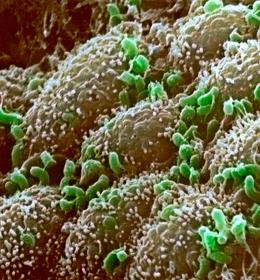Gut bacteria coax T cells to see them as friends.
 Don't kill your friends.Southampton General Hospital/SPL
Don't kill your friends.Southampton General Hospital/SPL
http://www.nature.com/news/2011/110921/full/news.2011.550.html
 Don't kill your friends.Southampton General Hospital/SPL
Don't kill your friends.Southampton General Hospital/SPL
Microbes living in the colons of mice coax immune cells in their host to embrace them rather than spark an immune response, according to a study published today in Nature1. That process happens not in a specialized organ called the thymus, where such immune cells are normally trained, but right in the microbes' front yard: the gut.
The findings suggest that illnesses such as ulcerative colitis and Crohn's disease might be kindled when this process goes awry.
One of the foundations of the immune system's capacity to fend off attackers is its ability to distinguish self cells from foreign cells. This task is performed in large part by a type of immune cell called a T cell.
Immature T cells are produced bearing a wide range of receptors, the T-cell receptors, that between them recognize a vast number of chemical structures, in this context known as antigens. T-cell training occurs in the thymus, where they are presented with large numbers of different 'self' antigens — antigens that are characteristic of the animal itself and not of microorganisms.
T cells with receptors that recognise these self-antigens are either removed or develop into regulatory T cells, which then circulate through the body, dampening down any potential immune response against the animal's own tissues. The rest of the T cells develop into effector T cells, with a key role in triggering the immune response to anything not recognised as self.
Friend or foe?
Not all foreign particles in the body warrant destruction, however. Microbes living harmlessly, and often helpfully, in the body evade the immune system's wrath, but researchers don't know how. Chyi-Song Hsieh of Washington University School of Medicine in St Louis, Missouri, and his colleagues now report that these microbes seem to provide localized instruction in the gut, telling immature T cells that recognize them to develop into regulatory T cells.
Previous work had suggested that regulatory T cells could be induced outside the thymus, but this is the first demonstration that such peripherally generated cells actually exist, says Kenya Honda, an immunologist at the University of Tokyo School of Medicine, who was not involved in the study.
Hsieh and his colleagues found that the amino-acid sequences of regulatory T-cell receptors in the mouse colon were different from those of receptors on T cells in other organs. "This suggested there was something very different about the colon in terms of the antigens being presented," Hsieh explains.
The group went on to examine whether the antigens to which the colon's regulatory T cells responded were generated by the bacteria or by mouse cells. The researchers used a viral vector to transfer the genes for two receptors from T cells from mouse colons into the bone marrow (where T cells originate) of mice that had been genetically modified to lack any T cells of their own. The treated bone marrow generated immature immune cells bearing these receptors, but these cells did not mature into regulatory T cells as expected.
Additional experiments suggested that this was because the recipient mice, which had been ordered from a mouse supplier, had different bacteria in their colons than the mice raised in Hsieh's lab and from which the T-cell receptor genes had been taken. When the two strains of mouse were housed together, allowing transfer of gut bacteria between the two, the recipients' immune cells did mature into regulatory T cells.
Hsieh says that this means that the gut bacteria must have triggered the immune cells that recognised them to mature into regulatory T cells, ensuring that the bacteria would be protected from their host's immune response.
Preventing inflammation
Finally, the researchers noticed that in mice with colitis, receptors normally present on regulatory T cells in the colon were instead present on effector T cells. "So if you don't develop a regulatory T-cell response, you could actually induce an inflammatory response to these bacteria," Hsieh says.
"It's a tour-de-force study that systematically examines these signals that guide differentiation in the periphery," says Ivaylo Ivanov, an immunologist at Columbia University Medical Center in New York, who was not involved in the study. "The idea here is that the commensal bacteria for some reason preferentially induce regulatory T cells, which then induce tolerance to these bacteria."
How exactly that happens is still unknown, but Hsieh says his lab is working on that question. The findings so far suggest that there may be a mechanism that distinguishes between two different types of foreign bacteria — harmful versus friendly.
Identifying that mechanism may open up new possibilities for treating colitis, Hsieh notes. Previously, researchers had no idea which antigens in the colon were being recognized to trigger the inflammation, but it may now be possible to figure that out. Armed with that knowledge, Hsieh says, "maybe you could generate regulatory cells that are specific to gut bacteria from a patient, then infuse them into their body."
http://www.nature.com/news/2011/110921/full/news.2011.550.html
Nenhum comentário:
Postar um comentário